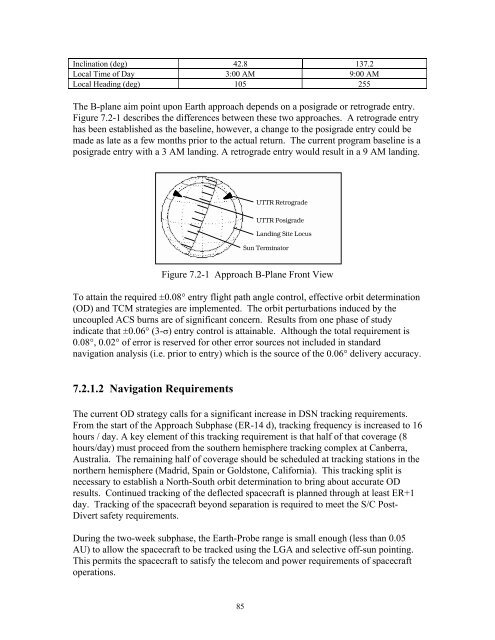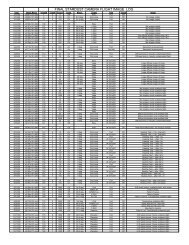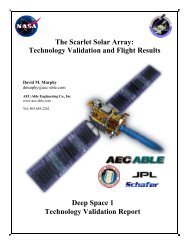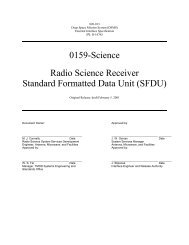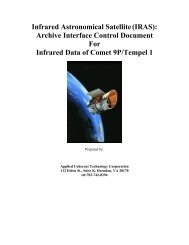MISSION PLAN - PDS Small Bodies Node
MISSION PLAN - PDS Small Bodies Node
MISSION PLAN - PDS Small Bodies Node
You also want an ePaper? Increase the reach of your titles
YUMPU automatically turns print PDFs into web optimized ePapers that Google loves.
Inclination (deg) 42.8 137.2<br />
Local Time of Day 3:00 AM 9:00 AM<br />
Local Heading (deg) 105 255<br />
The B-plane aim point upon Earth approach depends on a posigrade or retrograde entry.<br />
Figure 7.2-1 describes the differences between these two approaches. A retrograde entry<br />
has been established as the baseline, however, a change to the posigrade entry could be<br />
made as late as a few months prior to the actual return. The current program baseline is a<br />
posigrade entry with a 3 AM landing. A retrograde entry would result in a 9 AM landing.<br />
UTTR Retrograde<br />
UTTR Posigrade<br />
Landing Site Locus<br />
Sun Terminator<br />
Figure 7.2-1 Approach B-Plane Front View<br />
To attain the required ±0.08° entry flight path angle control, effective orbit determination<br />
(OD) and TCM strategies are implemented. The orbit perturbations induced by the<br />
uncoupled ACS burns are of significant concern. Results from one phase of study<br />
indicate that ±0.06° (3-σ) entry control is attainable. Although the total requirement is<br />
0.08°, 0.02° of error is reserved for other error sources not included in standard<br />
navigation analysis (i.e. prior to entry) which is the source of the 0.06° delivery accuracy.<br />
7.2.1.2 Navigation Requirements<br />
The current OD strategy calls for a significant increase in DSN tracking requirements.<br />
From the start of the Approach Subphase (ER-14 d), tracking frequency is increased to 16<br />
hours / day. A key element of this tracking requirement is that half of that coverage (8<br />
hours/day) must proceed from the southern hemisphere tracking complex at Canberra,<br />
Australia. The remaining half of coverage should be scheduled at tracking stations in the<br />
northern hemisphere (Madrid, Spain or Goldstone, California). This tracking split is<br />
necessary to establish a North-South orbit determination to bring about accurate OD<br />
results. Continued tracking of the deflected spacecraft is planned through at least ER+1<br />
day. Tracking of the spacecraft beyond separation is required to meet the S/C Post-<br />
Divert safety requirements.<br />
During the two-week subphase, the Earth-Probe range is small enough (less than 0.05<br />
AU) to allow the spacecraft to be tracked using the LGA and selective off-sun pointing.<br />
This permits the spacecraft to satisfy the telecom and power requirements of spacecraft<br />
operations.<br />
85


